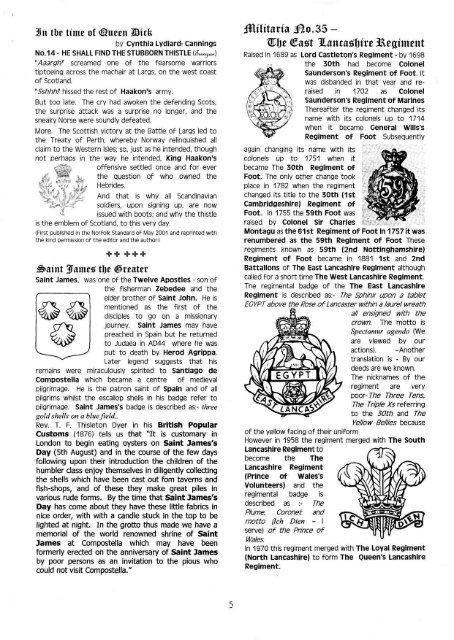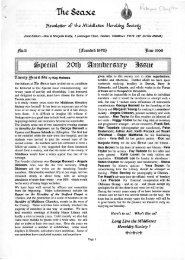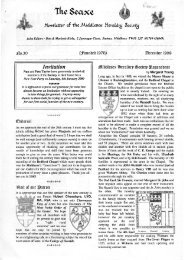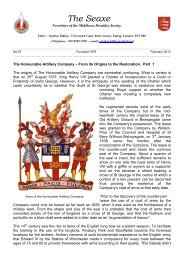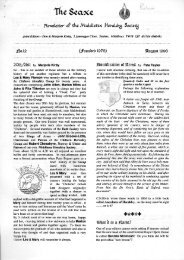The Seaxe - Middlesex Heraldry Society
The Seaxe - Middlesex Heraldry Society
The Seaxe - Middlesex Heraldry Society
Create successful ePaper yourself
Turn your PDF publications into a flip-book with our unique Google optimized e-Paper software.
In the time of Queen Dick<br />
by Cynthia Lydiard- Cannings<br />
No.14 - HE SHALL FIND THE STUBBORN THISTLE (Tennyson)<br />
"Aaargh!" screamed one of the fearsome warriors<br />
tiptoeing across the machair at Largs, on the west coast<br />
of Scotland.<br />
"Sshhh!" hissed the rest of Haakon's army.<br />
But too late. <strong>The</strong> cry had awoken the defending Scots,<br />
the surprise attack was a surprise no longer, and the<br />
sneaky Norse were soundly defeated.<br />
More. <strong>The</strong> Scottish victory at the Battle of Largs led to<br />
the Treaty of Perth, whereby Norway relinquished all<br />
claim to the Western Isles; so, just as he intended, though<br />
not perhaps in the way he intended, King Haakon's<br />
tJi., offensive settled once and for ever<br />
the question of who owned the<br />
Hebrides.<br />
And that is why all Scandinavian<br />
soldiers, upon signing up, are now<br />
issued with boots; and why the thistle<br />
is the emblem of Scotland, to this very day.<br />
(First published in the Norfolk Standard of May 2001 and reprinted with<br />
the kind permission of the editor and the author.<br />
+ + + + +<br />
Saint James the Greater<br />
Saint James, was one of the Twelve Apostles - son of<br />
the fisherman Zebedee and the<br />
elder brother of Saint John. He is<br />
mentioned as the first of the<br />
disciples to go on a missionary<br />
journey. Saint James may have<br />
preached in Spain but he returned<br />
to Judaea in AD44 where he was<br />
put to death by Herod Agrippa.<br />
Later legend suggests that his<br />
remains were miraculously spirited to Santiago de<br />
Compostella which became a centre of medieval<br />
pilgrimage. He is the patron saint of Spain and of all<br />
pilgrims whilst the escallop shells in his badge refer to<br />
pilgrimage. Saint James's badge is described as:- three<br />
gold shells on a blue field..<br />
Rev. T. F. Thisleton Dyer in his British Popular<br />
Customs (1876) tells us that "It is customary in<br />
London to begin eating oysters on Saint James's<br />
Day (5th August) and in the course of the few days<br />
following upon their introduction the children of the<br />
humbler class enjoy themselves in diligently collecting<br />
the shells which have been cast out from taverns and<br />
fish-shops, and of these they make great piles in<br />
various rude forms. By the time that Saint James's<br />
Day has come about they have these little fabrics in<br />
nice order, with with a candle stuck in the top to be<br />
lighted at night. In the grotto thus made we have a<br />
memorial of the world renowned shrine of Saint<br />
James at Compostella which may have been<br />
formerly erected on the anniversary of Saint James<br />
by poor persons as an invitation to the pious who<br />
could not visit Compostella."<br />
5<br />
Militaria No.35 -<br />
<strong>The</strong> East Lancashire Regiment<br />
Raised in 1689 as Lord Castleton's Regiment - by 1698<br />
the 30th had become Colonel<br />
Saunderson's Regiment of Foot. It<br />
was disbanded in that year and re-raised<br />
Saunderson's Regiment of Marines<br />
<strong>The</strong>reafter the regiment changed its<br />
name with its colonels up to 1714<br />
when it became General Wills's<br />
Regiment of Foot Subsequently<br />
again changing its name with its<br />
colonels up to 1751 when it<br />
became <strong>The</strong> 30th Regiment of<br />
Foot. <strong>The</strong> only other change took<br />
place in 1782 when the regiment<br />
changed its title to the 30th (1st<br />
Cambridgeshire) Regiment of<br />
Foot. In 1755 the 59th Foot was<br />
raised by Colonel Sir Charles<br />
Montagu as the 61st Regiment of Foot In 1757 it was<br />
renumbered as the 59th Regiment of Foot <strong>The</strong>se<br />
regiments known as 59th (2nd Nottinghamshire)<br />
Regiment of Foot became in 1881 1st and 2nd<br />
Battalions of <strong>The</strong> East Lancashire Regiment although<br />
called for a short time <strong>The</strong> West Lancashire Regiment.<br />
<strong>The</strong> regimental badge of the <strong>The</strong> East Lancashire<br />
Regiment is described as:- <strong>The</strong> Sphinx upon a tablet<br />
EGYPT above the Rose of Lancaster within a laurel wreath<br />
all ensigned with the<br />
crown. <strong>The</strong> motto is<br />
Spectamur agendo (We<br />
are viewed by our<br />
actions). -Another<br />
translation is - By our<br />
deeds are we known.<br />
<strong>The</strong> nicknames of the<br />
regiment are very<br />
poor- <strong>The</strong> Three Tens,<br />
<strong>The</strong> Triple Xs referring<br />
to the 30th and <strong>The</strong><br />
Yellow Bellies because<br />
of the yellow facing of their uniform<br />
However in 1958 the regiment merged with <strong>The</strong> South<br />
Lancashire Regiment to<br />
become the <strong>The</strong><br />
Lancashire Regiment<br />
(Prince of Wales's<br />
Volunteers) and the<br />
regimental badge is<br />
described as :- <strong>The</strong><br />
Plume, Coronet and<br />
motto (Ich Dien - I<br />
serve) of the Prince of<br />
Wales.<br />
In 1970 this regiment merged with <strong>The</strong> Loyal Regiment<br />
(North Lancashire) to form <strong>The</strong> Queen's Lancashire<br />
Regiment.


